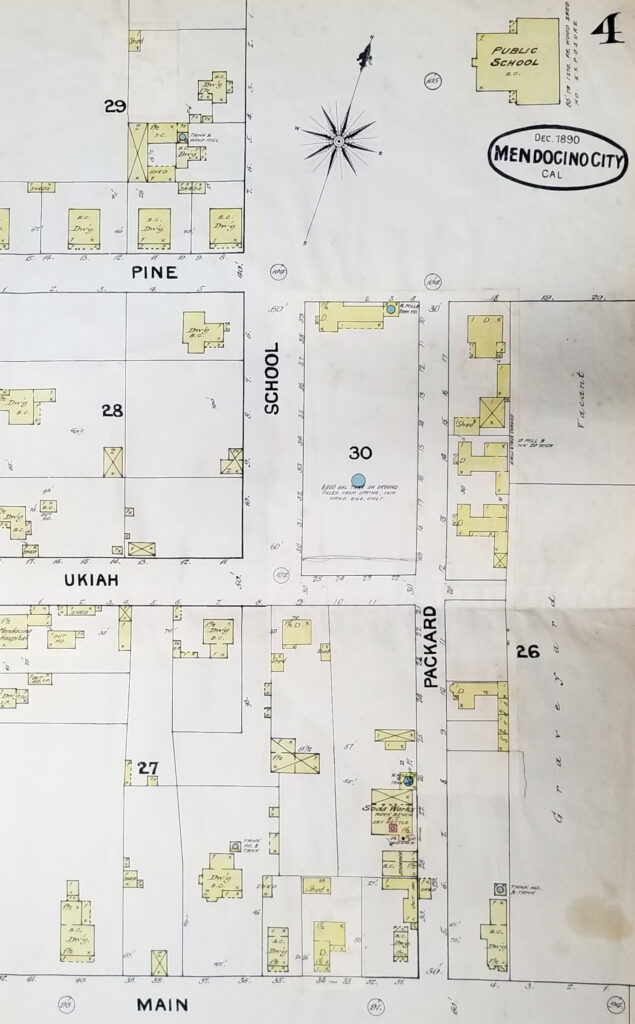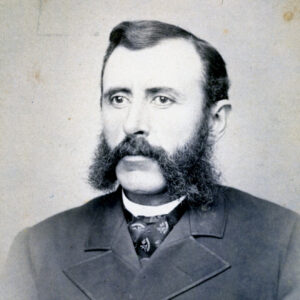On the far side of Mendocino, at the east end of Main Street, there is a narrow ribbon of pavement just a few blocks long now called Evergreen Avenue. Its name doesn’t conform to the protocol that most of the other north-south streets follow, which reflects the last names of early families, such as Lansing, Kelley, and Heeser. It refers instead to the nearby cemetery. But it once had another name – Packard Avenue – and this has an interesting history.

Much of the land in that part of town was owned at one time by David F. Lansing, the captain of the brig ONTARIO. This was the ship that brought a team of forty men and the first steam-powered sawmill to the Mendocino coast in 1852. When he died in 1877, Lansing’s heirs gradually sold off his original holdings.
One of the buyers was Justin E. Packard, who purchased a sizable tract in 1885. The “Packard Homestead,” as it came to be known, generally stretched northward from Main to Pine Street, and from Evergreen Cemetery on the east over to School Street on the west, excluding two lots on Main Street and the parcel on the northeast corner of Pine and Evergreen.

J. E. Packard, a native of Maine, was a successful watch repairman and jeweler who operated his business in a now-gone commercial building west of the Mendocino Hotel on Main Street that he shared with his brother, druggist C. O. Packard. He eventually opened a second jewelry store in Fort Bragg and was an inventor that received in 1888 a U. S. patent for a new fly trap.
Packard’s homestead was in an area of town known for its abundant water resources. This was particularly true of the large lot bounded by Ukiah, Evergreen, School and Pine Streets, where you can still find one of Mendocino’s few natural year-round ponds. Back in 1862, Lansing granted water rights to the lumber company “to take water for the mill from a small pond.” This watery spot was also put to good use for fire suppression, as the 1894 Sanborn map shows an “8,000-gallon water tank filled from a spring for hand engine only.”
On this same lot in 1891, a water tower with a windmill was built near the southwest corner of Evergreen and Pine Street. While it was torn down in 1937, property owner Barry Cusick rebuilt it in 1988 just to the east of its original location.
According to a Beacon article, Cusick was also forced to cap the spring-fed, hand-dug ten-foot well that had once provided water through a series of pipes and a domed brick tunnel to Cafe Beaujolais and adjacent structures on the south side of Ukiah Street. The pipes were purportedly still in place. Cusick said he first learned of the intricate water delivery network when owners of the cafe began to repair its water system and found they could not shut off the flow.
Strange to imagine, but the Packard Homestead was also the site of a small bottling plant from 1882 to about 1910, located just south of where Café Beaujolais is today. The plentiful water here was no doubt the reason for its location, as such a venture would require a reliable supply of water.
Today, all that can be seen are several at-grade water tanks scattered amid lush grass. But Packard and others built and operated a business here that produced, bottled, and delivered bubbly soda water, sarsaparilla, and beer. There was even an on-site icehouse since a cooling place was a necessary part of brewing lager beer.
In 1887, two years after his land purchase from the Lansings, Packard opened a road into his tract, from Main Street north to the new schoolhouse grounds. Various Sanborn maps from 1890 onward show the road as “Packard Avenue,” later “Packard-Evergreen Avenue,” then finally just “Evergreen” on the 1929 map.
Packard teamed up with Mendocino’s builder John D. Johnson to develop his now accessible property, subdividing it into lots and building several homes. This master carpenter (and undertaker) had a distinctive style that included bay windows, and lots of brackets, cornices, and fancy scroll work.
Johnson was an Englishman who came to Mendocino about 1880. He designed and built more than thirty-eight documented structures in Mendocino, twenty-four of which survive to this day. They include such well-known houses as the Joshua Grindle House, The MacCallum House, and the Blair House.
While he was creating his subdivision, Justin Packard was having legal issues. First, he was arrested in 1890 for attacking, with intent to kill, Professor Feddersen, a music teacher boarding at his home. The case was dropped as “it was a family matter.”
A year later he was in jail for kidnapping his own daughter and taking her to Maine where his parents kept her until Packard was forced by the court to return her to Mendocino.
Packard and his wife got divorced and the break-up forced the sale of his property. In March 1891 it was sold at public auction for $5,500 to his contractor, Mr. Johnson. At the time, Johnson had several homes under construction for Packard. Indeed, that summer he was just finishing Packard’s own new residence when Packard unexpectedly decided to move from Mendocino. By fall, Packard, with his new wife and his daughter, were gone, but his legacy remained for years afterward with his namesake street, Packard Avenue.